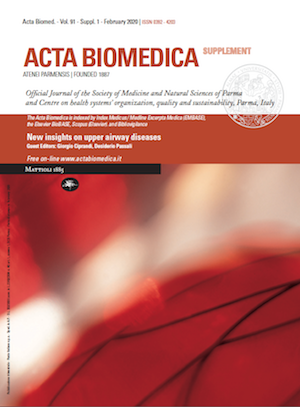A comparison between mometasone furoate nasal spray and intranasal glycyrrhetic acid in patients with allergic rhinitis: a preliminary study in clinical practice
Keywords:
glycyrrhetic acid, mannitol, glycerol, mometasone furoate, allergic rhinitis, topical treatment, clinical practiceAbstract
Allergic rhinitis (AR) is caused by an IgE-mediated inflammatory reaction consequent to the exposure to the causal allergen. Glycyrrhetic acid (GlyAc) is a natural compound extracted from the liquorice that exerts anti-inflammatory activity. This real-life study compared intranasal GlyAc, present in a medical device containing also glycerol and mannitol, with mometasone furoate nasal spray (MFNS) in 50 adult outpatients with AR. Both treatments lasted 2 months. Endoscopic signs, perception of symptom severity, assessed by VAS, and nasal function measured by rhinomanometry were evaluated at baseline (T0), after one (T1) and two (T2) months. The intergroup analysis showed that at T1 there was no significant difference between groups about the use of decongestants and antihistamines, turbinate hypertrophy and pale mucosa, perception of olfaction and snoring. At T2 there was no significant difference between groups about use of relievers, all endoscopic signs, and perception of nasal discomfort, nasal obstruction, olfaction, and snoring. The intragroup analysis showed that in MFNS group there was a significant change during the entire period of treatment for all parameters except watery rhinorrhea (sign) and ocular discomfort; in GlyAc group there was a significant change during the entire period of treatment for all parameters. In conclusion, this preliminary study, conducted in clinical practice, evidenced that intranasal CysAC plus mannitol was able to significantly improve nasal endoscopic signs, perception of symptoms, and nasal function in patients with AR. Therefore, GlyAc could be a reasonable therapeutic option to control allergic inflammation.
References
2) Kuo CRW, Chan R, Lipworth B. Does Unified Allergic Airway Disease Impact on Lung Function and Type 2 Biomarkers? Allergy Asthma Clin Immunol 2019; 15:75
3) Ciprandi G, Cirillo I, Vizzaccaro A, Milanese M, Tosca MA. Nasal obstruction in patients with seasonal allergic rhinitis: relationships between allergic inflammation and nasal airflow. Intern Arch Allergy Immunol 2004;134:34-40 J Clin Med
4) Ciprandi G, Cirillo I, Klersy C, Marseglia GL. Nasal obstruction is the key symptom in hay fever patients. Otolaryngol Head Neck Surg 2005; 133: 429-35
5) Cox L. Approach to Patients With Allergic Rhinitis: Testing and Treatment. Med Clin North Am 2020;104:77-94
6) Fokkens WJ. Local Corticosteroids, Why Are They Not Used More / Properly ? Rhinology 2019;57:81
7) Ciprandi G, Varricchio A. The relevance of the Mometasone Furoate Nasal Spray Device in clinical practice. J Biol Reg 2018;32:1051-4
8) Choi E, Chandran NS, Tan C. Corticosteroid Phobia: A Questionnaire Study Using TOPICOP© Score. Singapore Med J 2019 (in press)
9) Magna M, Pisetsky DS. The role of HMGB1 in the pathogenesis of inflammatory and autoimmune diseases. Mol Med 2014;20:138–146
10) Sabbadini C, Bordin L, Donà G, Manso J, Avruscio G, Armanini D. Licorice: from pseudohyperaldosteronism to therapeutic use. Font Endocrinol 2019;10:484
11) Cavone L, Cuppari C, Manti S, Grasso L, Arrigo T, Calamai L, et al. Increase in the level of proinflammatory cytokine HMGB1 in nasal fluids of patients with rhinitis and its sequestration by glycyrrhizin induces eosinophils cell death. Clin Exp Otorhinolaryngol 2015;8:123–8
12) Passali D, Cappello C, Passali GC, Cingi C, Sarafoleanu C, Bellussi LM. Nasal mucociliary transport time alteration: efficacy of 18 B glycyrrhetinic acid. Multidisc Resp Med 2017;12:29
13) Mansi N, D’Agostino G, Scirè AS. Allergic Rhinitis in Children: A Randomized Clinical Trial Targeted at Symptoms. Indian J Otolaryngol Head Neck Surg 2014;66:386–393
14) Damiani V, Camaioni A, Viti C, Schillani G, Foltran F, Sciré AS, et al. Short-term efficacy of Narivent in the treatment of nasal congestion. Open Med Dev J 2012;4:66-72
15) Wise SK, Lin SY, Toskala E, Orlandi RR, Akdis CA, Alt JA, et al. International consensus statement on allergy and rhinology: allergic rhinitis. Int Forum Allergy Rhinology 2018;8:108-352
16) Ciprandi G, Marseglia GL, Klersy C, Tosca MA. Relationships between allergic inflammation and nasal airflow in children with persistent allergic rhinitis due to mite sensitization. Allergy 2005;60:957-60
17) Gelardi M, Piccininni K, Quaranta N, Quaranta V, Silvestri M, Ciprandi G. Olfactory dysfunction in patients with chronic rhinosinusitis with nasal polyps is associated with Clinical-Cytological Grading severity. Acta ORL Italica 2019;39:329-35
18) Nosetti L, Piacentini G, Macchi A, De Bernardi F, Simoncini D, Nicoloso M, et al. Nasal Cytology in Children with Primary Snoring and Obstructive Sleep Apnoea Syndrome. Int J Pediatr Otorhinolaryngol 2019;122:133-7
19) May JR, Dolen WK. Evaluation of Intranasal Corticosteroid Sensory Attributes and Patient Preference for Fluticasone Furoate for the Treatment of Allergic Rhinitis. Clin Ther 2019;41:1589-96
20) Damiani V, Camaioni A, Viti C, Scirè AS, Morpurgo G, Gregori D. A Single-Centre, Before-After Study of the Short- And Long-Term Efficacy of Narivent(®) in the Treatment of Nasal Congestion. J Int Med Res 2012;40:1931-41
Downloads
Published
Issue
Section
License
This is an Open Access article distributed under the terms of the Creative Commons Attribution License (https://creativecommons.org/licenses/by-nc/4.0) which permits unrestricted use, distribution, and reproduction in any medium, provided the original work is properly cited.
Transfer of Copyright and Permission to Reproduce Parts of Published Papers.
Authors retain the copyright for their published work. No formal permission will be required to reproduce parts (tables or illustrations) of published papers, provided the source is quoted appropriately and reproduction has no commercial intent. Reproductions with commercial intent will require written permission and payment of royalties.







